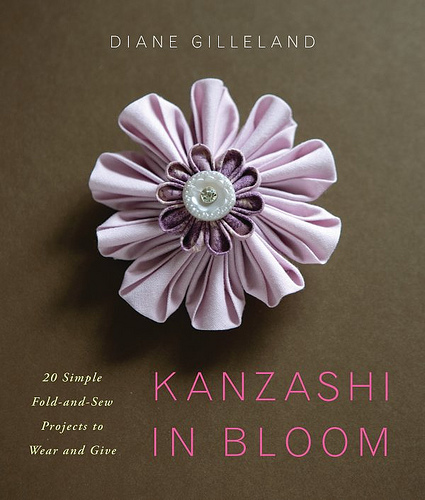
I am honored to be included in Diane Gilleland’s Kanzashi in Bloom book blog tour, and I so happy to introduce this book and its amazing author to you!

The Author:
I first “met” Diane online in 2005 when she collaborated with me on CROQ Zine. She has always been one of my favorite crafty contributors to the zine, with clear, crisp writing, and amazing tutorial photography. Then I was fortunate enough to meet her in person when I moved back to Portland and attended a Church of Craft meeting. Since then, I’ve had many opportunities to see Diane at some of the many crafty happenings around Portland, and she’s become a favorite crafty friend of mine. Also, she’s one of the nicest, most honest people I know, not to mention one of the most innovative crafty stars in the craft universe. If you ever get a chance to meet Diane, go for it! She rocks!

The Book:
Kanzashi in Bloom by Diane Gilleland (Publisher: Watson-Guptill, 2009) Buy it at Amazon.
Kanzashi tsumami is the Japanese art of folding delicate squares of silk into three-dimensional flower petals. In the United States, the online craft culture has sprouted a renewed interest in making Kanzashi with American crafters devising simplified ways to create these gorgeous fabric flowers and incorporating more user-friendly materials like cotton and synthetic fabrics along with the traditional silks.
Kanzashi in Bloom takes the American interpretation of Kanzashi a step further, presenting modern, more easily executed flower designs as elements in a variety of fun, fashionable, hip craft projects. Kanzashi in Bloom offers advice on materials, three petal-folding styles, and techniques for assembling a Kanzashi flower. You’ll also find instructions for 20 projects to wear and give as gifts.
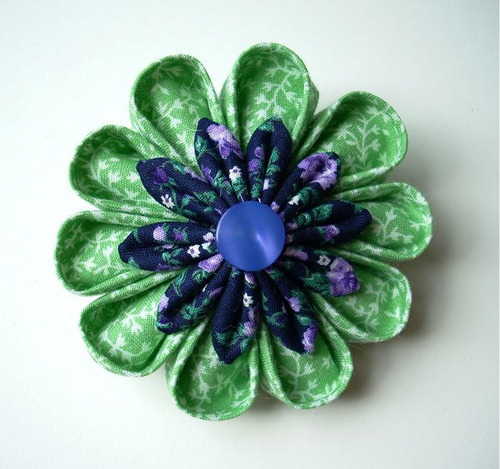
I asked Diane a couple questions about making kanzashi:
When did you fold your very first kanzashi?
It was sometime in 2006. I discovered them somewhere during one of those wandering web-surfing sessions and was hooked. I wish I’d kept the first flower I made. It was 100% wonky. But now, I’d frame it!
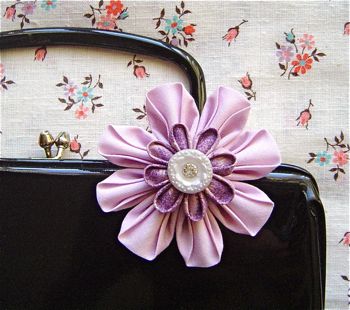
My favorite things about the book:
Diane is a great teacher, and her writing is clear, concise, and so easy to read and understand; it’s really a pleasure to read this book! She breaks everything down into easy-to-follow steps that are accompanied by great instructional photos (taken by her mom, Pam). She also gives great information about materials used in making kanzashi, from fabrics to adhesives! I really appreciated the two pages dedicated to various glues used in the projects and why they were good (or not good) choices for use with different materials. The book includes instructions for how to create three different types of petal folds, but also includes information on how to construct different types of flowers and how to create your own unique flowers using different numbers of petals, different sizes of petals, and different materials. She also expands beyond flowers and gives instructions for making kanzashi hearts and butterflies.
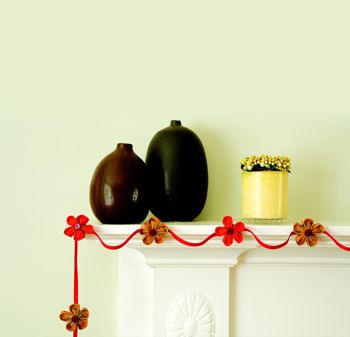
As I said before, Diane is an innovative crafter, and I love the projects she came up with. My favorites are the Stretch and Bloom Headband, the Tiny Blossom Earrings, the kanzashi garland, and the Sampler Wall Hanging, but all of the projects are solid. There are twenty project ideas included, and they are a great springboard for making your own kanzashi-adorned creations.

Dollar Store Crafting and Kanzashi:
I think you would do better to go to the fabric store (or reuse old garments, sheets, etc.) for your actual kanzashi materials. You can get cute fabric that will work well for a lot less than you would spend on say, a dish towel at the dollar store, and the dish towel probably won’t work as well (or look as good) as a fat quarter of quilting cotton would. This blog is about saving money and frugal crafting, not pigeon-holing EVERY craft into dollar store materials! You will, however, find a lot of the materials called for in the projects in the book at the dollar store. Look for ribbon, buttons, some glues, and flower stamens at the dollar store.
The dollar store is a great source for items to embellish with kanzashi! We have posted many projects here at Dollar Store Crafts that would be great candidates for the addition of a kanzashi flower or two! Check out these and imagine a dainty folded fabric flower attached to them:

One of Diane’s projects, the Sampler Wall Hanging, could be made with a dollar store placemat. Make a few kanzashi, divide your placemat into a grid and add hanging tabs and a dowel (or twig!) for hanging, and there you go!
Project Estimate:
- Placemat, $1
- 6 kanzashi flowers, made from scrap fabric, on hand
- Ribbon, on hand or $1
- Dowel, twig, or other item for hanging, $1 or on hand
Total cost: $1 and up




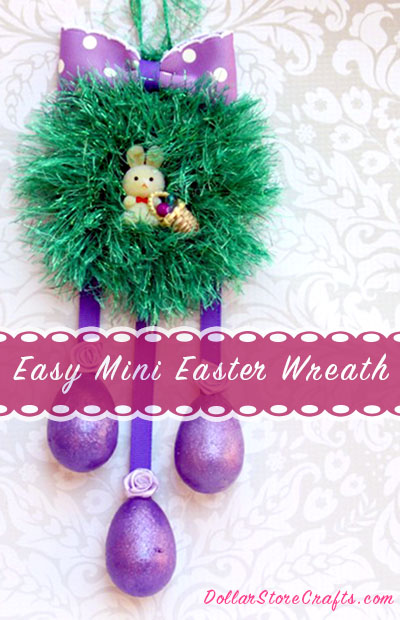


7 Comments
iHanna
Great questions and nice intro to the book and this craft.
I like that you think about cheap materials and saving but say that not everything can be bargained for. :-)
Valerie
Beautiful! I love the bugs….
Are you talking portland maine or portland oregon?
heather
Portland, Oregon!
pam
Love your wall hanging! And what a lovely presentation of Diane’s book.
Thank you for making the effort to come to the Kitten last week and introducing yourself! I am enjoying your blog very much!
dot
great interview!
Ruthie
Nice post and it is very useful for an idea, but directions to making a Kanzashi flower are a must. Buying the book to find out how to do it, is in effect pointless when trying to save money.
heather
@Ruthie
I value your input on this! Thanks for taking the time to comment.
Here are some links for making kanzashi:
http://www.mookychick.co.uk/diy_ethic/kanzashi_tutorial.php
http://www.instructables.com/id/How-to-make-a-kanzashi-folded-fabric-flower-pin/
I still recommend checking the book out at the library or thumbing through it at a bookstore – it’s a really great book with lots of good ideas.
Heather